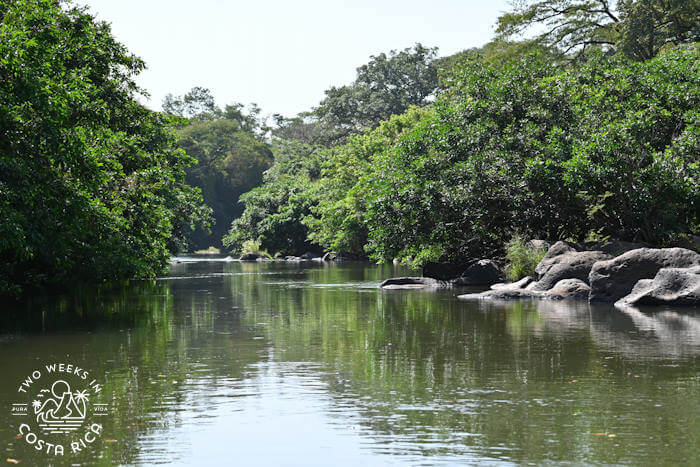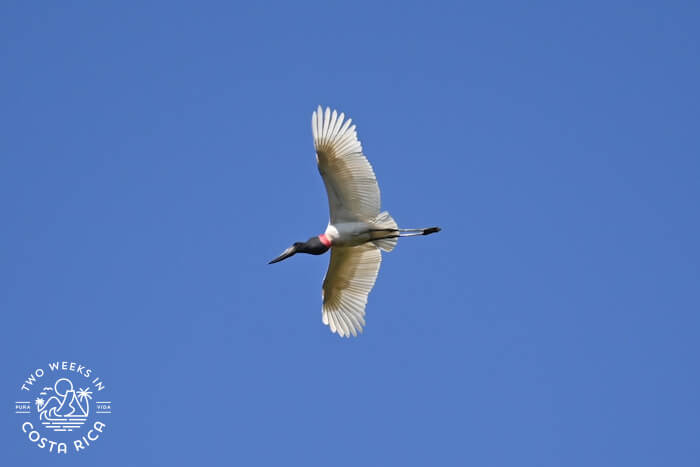Last Updated: May 28, 2024
If you are visiting a beach destination in Costa Rica’s Guanacaste Province, you may be wondering where you can see wildlife nearby. After all, many beach spots in this area offer lots of amenities and awesome beach time, but not as much wildlife. One fun option is a river float tour to see birds, monkeys, and crocodiles. In this post, we’ll share our family’s experience, tell you what we saw, and explain how you can arrange this activity.

Overview
Costa Rica’s Guanacaste region is seasonally very dry and doesn’t have lush rainforest like other places around the country. For this reason, animals and birds are a little harder to see. Often, they hang out near freshwater sources like wetlands, ponds, and rivers.
A river float tour offers a good chance to see some of Costa Rica’s famous wildlife. The tour takes you inland to a sizable river. Depending on water levels, you’ll gently cruise down either the Tenorio or Corobici River. Both rivers flow into a giant wetland ecosystem (Palo Verde) and are home to a lot of different creatures.

Location
The tour does involve some driving. We were picked up from our hotel in Tamarindo and it took about two hours to get to the river.
We broke up the ride with a restroom/coffee stop, and our guide, Gabriel, was very good at engaging with us. He taught us a lot about the area and what we were seeing outside the van windows.
On the way back, we stopped for lunch and at a gorgeous waterfall (see below).
The drive time from Tamarindo (two hours) is similar from towns like Playa Grande, Conchal, Flamingo, Potrero, and Las Catalinas.
From beach towns like Playas del Coco, Playa Hermosa, or resorts on the Papagayo Peninsula, travel time to the river is only about one hour.

River Float Tour Guanacaste – Our Experience
Gearing Up & Setting Off
Right off the highway near the town of Canas, we strapped on lifejackets and helmets, then followed our guide down a short path. There, on the bank of the Tenorio River, was a small rubber raft waiting for us.

Gabriel, our naturalist guide, introduced us to Alan.
Alan was a local from the area who grew up on the river. He would be our captain for the seven mile (11 km) trip down the Tenorio River. Gabriel would be with us too, helping to spot wildlife and telling us all about it.
In just a few minutes, we were loaded into the raft. Alan paddled to the center of the river and we floated slowly downstream. The river was moving swiftly but was very calm.

First Wildlife Sightings
Just minutes into our adventure, Alan started to backpaddle and got Gabriel’s attention. In the nearby tree was a Boat-billed Heron. These birds, we learned, are nocturnal and like to sleep in trees during the day. They have a big boat-shaped beak, hence the name.
Alan paddled on and almost immediately, our guide pointed out a big rock up ahead. On top was a giant crocodile sunning itself. It was at least 10 feet (three meters) long! We approached and Alan eased us past the giant creature at a safe distance.

Our next stop was a large family of bats, hanging under a rocky cliff. While Alan held the boat steady, Gabriel explained that Costa Rica has over 100 different species of bats. He quickly identified these as long-nosed proboscis bats. He told us they are very important for the ecosystem because they can eat thousands of mosquitoes per day.

The Tranquil River
Our trip down the river continued much like this. Since we were moving swiftly with the current, we were sneaking up on animals almost constantly.
Even when our guides weren’t pointing out something new, we were enjoying the scenery of the river. The trees were very thick and green, which was a nice contrast to the environment in Guanacaste during the dry season (January-April).
We also learned about some of the trees and plants.
At one point, Alan took a fern from the riverbank. He showed us how it can be used to make a temporary tattoo on your skin. Gabriel explained that the powder on the fern is part of its defense mechanism, protecting it from hungry insects.

Abundant Birds
Along the riverbank, we spotted a lot of different birds.
A short list of memorable ones were the Bare-throated Tiger Heron, Anhinga, Yellow-crowned Night Heron, Groove-billed Ani, Squirrel Cuckoo, Little Blue heron, Green Heron, Ringed Kingfisher, and some large Osprey.

Lazy Monkeys
We also got to see some monkeys. One troop of howler monkeys was eating fruit and leaves from a tree hanging over the river. They didn’t seem too bothered by us as Alan paddled the raft almost right under them.

Later in the trip, we saw one lonesome white-faced monkey too. But he was much shyer and disappeared quickly into the bushes.
Wildlife Surprises
A huge highlight was seeing our guides get really excited by some unexpected wildlife sightings.
First, it was two large birds flying overhead. The stork-like birds were called Jabiru. They are rare and only found in a few parts of Costa Rica. We got a nice camera shot as they flew by.

Jabiru are huge birds. They can be almost three feet (one meter) tall when standing and have an enormous wingspan of up to nine feet (2.8 meters)!
We didn’t realize how special of a sighting the birds were until we saw our guides enthusiastically telling other guides about it later.
Another awesome surprise was when we noticed something splashing next to the raft as we went down a gentle rapid. It turned out to be a neotropical river otter! Our guide had only seen them a couple of times in his life.
A Tasty Lunch
Not long after the excitement of the river otter, we reached the raft take-out spot. Our van driver, Alberto, was there waiting for us. After a cold drink and some fresh pineapple, we loaded into the van.
About a half hour later, we stopped for a nice typical-style Costa Rican lunch at a restaurant along the river’s edge.

Llanos de Cortez Waterfall Stop
Our second stop on the way back to the hotel was the Llanos de Cortez Waterfall. We had visited this waterfall several times before, but it never gets old. The waterfall is a beautiful veil-shaped cascade with a big natural swimming pool at the bottom.

The trail down to the falls is short and not very difficult. There is also some nice shade and lots of sandy spots to sit and relax. For much more, read our full article, Llanos de Cortez Waterfall.
After splashing around with the kids for about a half-hour, we returned to the van for the remaining drive back to the hotel.
Conclusion
Our family really enjoyed the river float tour in Guanacaste. After doing beach activities in the days prior, it was the perfect mix of nature and adventure that we needed. Even though it involved a bit of driving, it was completely worth it.

Booking a Tour
If you would like to experience the river float trip from Guanacaste for yourself, we would be happy to help set it up for you. Just use the links below. Booking through us costs the same and supports our website.
Cost (2024)
Group Tour: $133 per person adults. $87 per person children (ages 5-11). Rates plus 13% tax.
Private Tour (only your family/group): $170 per person adults. $90 per person children (ages 5-11). Rates plus 13% tax.
Minimum Age
The minimum age is 5.
We did this tour with our kids who were 8 and 5 year old at the time. Both did great. It was a little hot on the raft for them at times, but we were able to keep them happy with some foldout wildlife guides that they used to help us identify birds and animals.
Duration
Full day tour (6-8 hours door to door). Pick up will be earlier in the morning (around 7:00 or 7:30 a.m.) with a late afternoon return to your accommodations. Exact timing depends on your pickup location.
What’s Included
Round-trip transportation from your hotel or vacation rental home, bilingual naturalist guides, rafting safety equipment, waterfall entrance fees, lunch, fruit, and drinks.
Have a question about the river float tour to see wildlife in Guanacaste? Leave a comment below.
Looking for more information to help you plan your trip? Check out these posts:
Guanacaste, Costa Rica: Regional Snapshot – This post will give you an overview of the Guanacaste region’s weather, landscape, and more.
Palo Verde National Park: A Wildlife Tour Through Guanacaste’s Wetlands – This tour is similar but is on a stable pontoon boat and explores a slightly different area.
Rincon de La Vieja National Park: Volcanic Vents and Tropical Forest – This is another popular day trip from Guanacaste’s beach towns.

